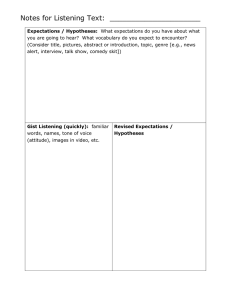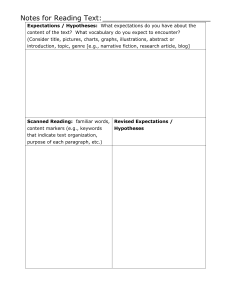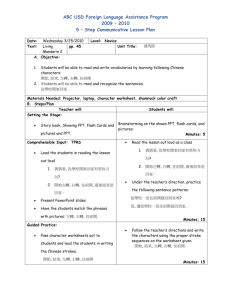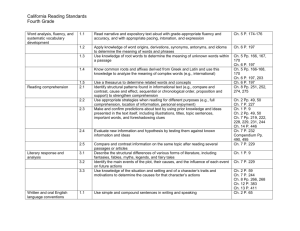Date - Susanlaoshi
advertisement
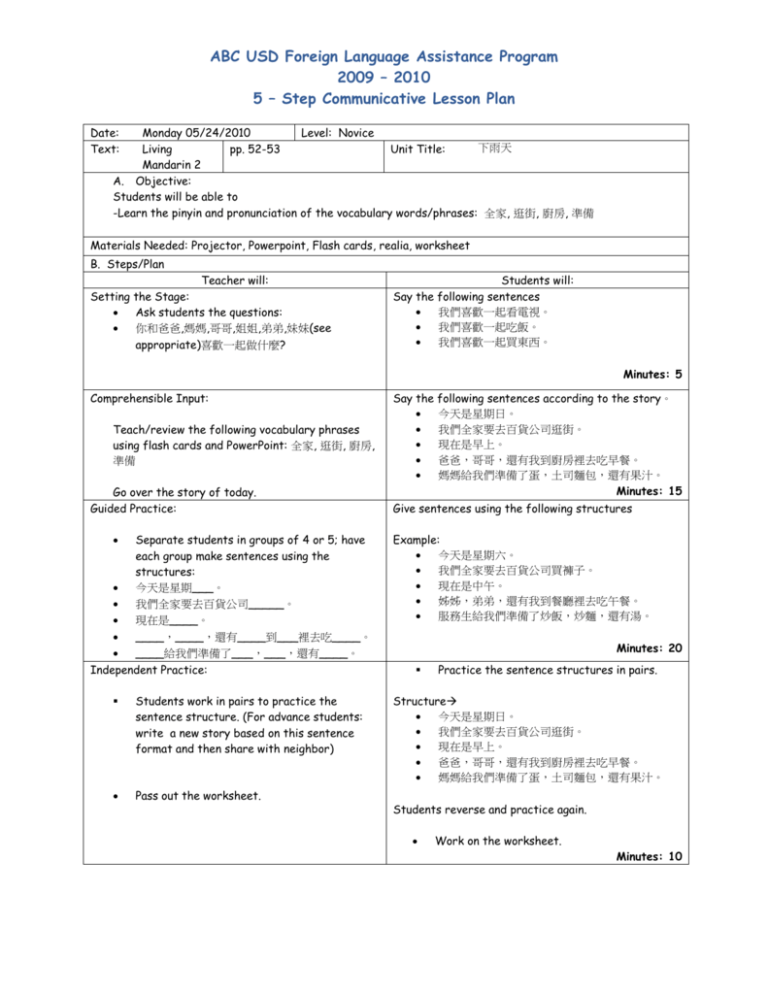
ABC USD Foreign Language Assistance Program 2009 – 2010 5 – Step Communicative Lesson Plan Date: Text: Monday 05/24/2010 Level: Novice 下雨天 Living pp. 52-53 Unit Title: Mandarin 2 A. Objective: Students will be able to -Learn the pinyin and pronunciation of the vocabulary words/phrases: 全家, 逛街, 廚房, 準備 Materials Needed: Projector, Powerpoint, Flash cards, realia, worksheet B. Steps/Plan Teacher will: Setting the Stage: Ask students the questions: 你和爸爸,媽媽,哥哥,姐姐,弟弟,妹妹(see appropriate)喜歡一起做什麼? Students will: Say the following sentences 我們喜歡一起看電視。 我們喜歡一起吃飯。 我們喜歡一起買東西。 Minutes: 5 Comprehensible Input: Teach/review the following vocabulary phrases using flash cards and PowerPoint: 全家, 逛街, 廚房, 準備 Go over the story of today. Guided Practice: Separate students in groups of 4 or 5; have each group make sentences using the structures: 今天是星期___。 我們全家要去百貨公司_____。 現在是____。 ____,____,還有____到___裡去吃____。 ____給我們準備了___,___,還有____。 Independent Practice: Students work in pairs to practice the sentence structure. (For advance students: write a new story based on this sentence format and then share with neighbor) Pass out the worksheet. Say the following sentences according to the story。 今天是星期日。 我們全家要去百貨公司逛街。 現在是早上。 爸爸,哥哥,還有我到廚房裡去吃早餐。 媽媽給我們準備了蛋,土司麵包,還有果汁。 Minutes: 15 Give sentences using the following structures Example: 今天是星期六。 我們全家要去百貨公司買褲子。 現在是中午。 姊姊,弟弟,還有我到餐廳裡去吃午餐。 服務生給我們準備了炒飯,炒麵,還有湯。 Minutes: 20 Practice the sentence structures in pairs. Structure 今天是星期日。 我們全家要去百貨公司逛街。 現在是早上。 爸爸,哥哥,還有我到廚房裡去吃早餐。 媽媽給我們準備了蛋,土司麵包,還有果汁。 Students reverse and practice again. Work on the worksheet. Minutes: 10 UCLA Language Materials Project 2 Evaluation/Assessment/Closure: Have students share two new sentences with their shoulder partners what they have learned today. Say the following sentences 1. 我們全家要去餐廳吃飯。 2. 媽媽給我們準備了衣服, 褲子, 還有鞋子。 Minutes: 5 C. National Standards (Explain in detail): Communication, Cultures, Connections, Comparisons, Communities Communication : Students will be working in pairs and in groups to discuss sentences, expressing the new vocabularies they learn today. Connections : Students will connect vocabularies that they have learned before and use these words in the new sentence structures. D. Language Arts (Explain in detail): listening/speaking/reading/writing strategies; language conventions Listening: Students will listen to the teacher’s pronunciation and follow along as she says each word so that they will also be able to pronounce it accurately Speaking: Students will talk with the teacher and their partner, practicing pronunciation of new words and phrases. Reading: Students will learn characters and phrases that they are expected to recognize on menus, etc. when outside of the classroom. Writing: Students will practice writing the characters of the words and phrases that they learn in the lesson, and will complete character worksheets with the pinyin. E. Language Development (Explain in detail): listening/reading comprehension, speaking, word analysis, reading fluency Listening comprehension: Students will develop their listening comprehension by listening closely to the teacher for the pronunciation of vocabulary words. Reading comprehension: Students will develop their reading comprehension skills when reading characters written on the board or on the teacher’s PowerPoint presentation. Speaking fluency: Students will practice saying sentences out loud with the teacher in choral responses and again with their neighbors. http://lmp.ucla.edu
